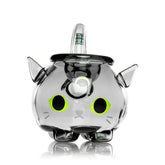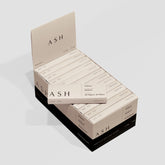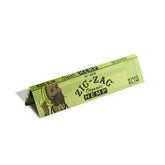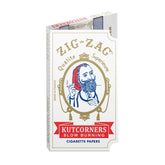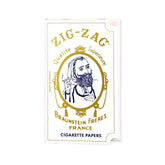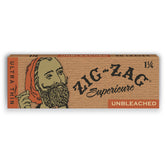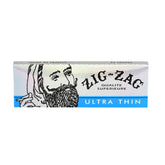-
Vendor:RAW
RAW Cones Classic 1-1/4 Size (50 Pack)
Introducing the Classic Series RAW Classic papers are crafted from natural fibers, ensuring the highest quality unbleached rolling papers available. Renowned for their slow-burning properties, these RAW cones offer unparalleled convenience by coming pre-rolled, saving you valuable time that would otherwise be spent rolling....- $19.99
- $19.99
- Unit price
- per
-
Vendor:RAW
RAW Classic 1 1/4 Rolling Papers (Pack of 6)
Raw 1 1/4 classic rolling papers are natural, unbleached, and offer a slow, even burn. With a smooth texture and pure taste, they provide a healthier and enjoyable smoking experience. Features Size: 78mm (L) x 44mm (H) Acacia gumline Translucent ultra-thin rolling paper Naturally...- $9.99
$12.99- $9.99
- Unit price
- per
-
Vendor:Blazy Susan
Blazy Susan Pink Paper Cones
Product Information 1 1/4 Pink Pre-Rolled Cones - 6 Pack Retail Unit: One (1) Display pack. Each display pack contains 21 packs and each pack contains six (6) 1 1/4 pre-rolled pink cones. Total 126 cones per display pack. Cone Box Size: 4.6" x 1.5"...- From $17.99
- From $17.99
- Unit price
- per
-
Vendor:DankStop
1-1/4" Unbleached Rolling Papers w/ Tips
With the new Unbleached Rolling Papers from DankStop comes a convenient magnet locking case with built-in tips! There are plenty of tips for every one of the 32 leaves that are in each pack. Now you always have your slow-burning unbleached papers and tips...- From $4.99
- From $4.99
- Unit price
- per
-
Vendor:King Palm
King Palm Natural Pre Rolled Palm Leafs (Pack of 25)
- From $19.99
- From $19.99
- Unit price
- per
-
Vendor:RAW
RAW Natural Unrefined Pre-Rolled Filter Tips - 1 Bag of 200 Tips
You will receive 200 prerolled filter tips diameter : 6,5mm / length : 18mm Made of All Natural, Chemical and Chlorine Free Fibers Vegan Friendly Windmill powered product Description RAW is the culmination of a 12 year project to produce most natural rolling paper...- $14.99
- $14.99
- Unit price
- per
-
Vendor:ZIG-ZAG
ZIG-ZAG Cones 1-1/4 Size (50 Pack)
Introducing the Must-Have Pre-rolled Rolling Papers by Zig Zag Rolling Papers! Say goodbye to subpar rolling papers, flimsy rolling accessories, and low-quality pre-rolled papers. Zig Zag Rolling Papers has you covered with our premium pre-rolled cones, designed to make your rolling experience hassle-free and...- $14.99
- $14.99
- Unit price
- per
-
Vendor:ASH Rolling Paper
Rolling Papers | Medium | Organic | Box
The Organic collection medium size slim rolling papers come in a raw, neutral pack. Made from 100% organic wood pulp paper with a natural Acacia gum seal, these papers provide an elevated and quality experience WHAT'S INSIDE: Medium size papers: 44mm by 76mm Capacity: approx. 0.5...- $79.99
$96.00- $79.99
- Unit price
- per
-
Vendor:Blazy Susan
Pink Pre Rolled Cones | 98mm | 50 Count
If you want to add some fabulous to your smoking routine, Blazy Pink Rolling Cones are what you’re looking for. Not only are they colorful, pink, of course, but they’re also Non-GMO and Vegan-friendly! Made in France using premium wood pulp and materials. These...- $19.99
- $19.99
- Unit price
- per
-
Vendor:Vibes
VIBES Ultra Thin Rolling Papers
These Vibes rolling papers are crafted with the idea of maintaining the purity and potent flavor of your herb material. Made from double-pressed papers, these fine rolling papers are ultra thin and lined with real Arabic gum for quality flavor and a smooth burn....- From $2.99
- From $2.99
- Unit price
- per
-
Vendor:Vibes
VIBES Hemp Rolling Papers w/ Tips
These all-natural hemp rolling papers are thin enough to get great flavor from your herbs and they provide a slow and even burn. Includes paper crutch tips. Purchase as a single booklet or a full box of 24 booklets. Available in 1 1/4 size. Vibes...- From $4.99
- From $4.99
- Unit price
- per
-
Vendor:Vibes
VIBES Ultra Thin Rolling Papers w/ Filters
These ultra thin rolling papers offer the thinnest paper on the market for a king size and provide the best flavor experience. Available for purchase in single booklets or as a full box of 24 booklets. Choose 1 1/4 Inch or Kingsize Slim. Vibes...- From $4.99
- From $4.99
- Unit price
- per
-
Vendor:Zig Zag
Zig Zag Organic Hemp Rolling Papers
A world renowned brand, Zig Zag Rolling Papers have been famous for their quality for decades. These Organic Hemp papers are made in France from the best materials. Full Boxes contain 24 booklets each Highlights Organic rolling papers 32 leaves per booklet King Slim...- From $3.99
- From $3.99
- Unit price
- per
-
Vendor:Vibes
VIBES Ultra Thin Rolling Papers w/ Tips
VIBES Ultra Thin Rolling Papers w/ Tips Experience the ultimate in rolling paper quality with VIBES Ultra Thin Rolling Papers w/ Tips. Crafted to provide the thinnest paper on the market, these papers guarantee a premium smoking experience like no other. Key Features: Ultra...- $4.99
- $4.99
- Unit price
- per
-
Vendor:Zig Zag
Zig Zag Orange Rolling Papers | 1 1/4 Inch
The Zig-Zag 1 1/4 size papers are easy to roll and slow burning. The classic orange packs are the most popular Zig-Zag paper. Each booklet contains 32 leaves made from natural flax plant fibers to form a smooth, slow-burning rolling paper. Papers are lined...- From $4.99
- From $4.99
- Unit price
- per
-
Vendor:Zig Zag
Zig Zag Cut Corner Rolling Papers
Zig Zag Rolling Papers are made with flax fibers and each leaf features a natural Arabic gumline to seal your hand rolled cigs. The Cut Corner style of rolling papers feature a clipped corner on each sheet to help map out the paper in low-visibility situations...- From $4.99
- From $4.99
- Unit price
- per
-
Vendor:Zig Zag
Zig Zag White Single Wide Rolling Papers
These Zig Zag White Single Wide Rolling Papers are made in France and feature 32 leaves per booklet. Each leaf is made using natural flax plant fibers and is lined with 100% natural Arabic gum. Available as a single booklet (32 papers) or a...- From $4.99
- From $4.99
- Unit price
- per
-
Vendor:RAW
RAW Classic Rolling Papers
RAW Classic Rolling Papers Product Information: Crafted from vegan, unbleached plant fibers Finished with the purest natural tree sap gum line Translucent natural light brown color due to hybrid blend of unbleached fibers Watermarked with patented Crisscross watermark for preventing runs Smooth and even-burning...- From $26.99
- From $26.99
- Unit price
- per
-
Vendor:Zig Zag
Zig Zag Unbleached Rolling Papers
Originating in France, these Zig Zag Unbleached Rolling Papers contain no added chemicals so that users can obtain the purest flavors from their herbs. These watermarked papers are ultra-thin, slow burning, and lined with arabic gum for a perfect seal. Full Boxes contain 24...- From $3.99
- From $3.99
- Unit price
- per
-
Vendor:Zig Zag
Zig Zag Ultra Thin Rolling Papers
These Zig Zag rolling papers are ultra thin to provide you with the best taste from your herbs or whatever you smoke. Zig Zag has been around for a long time and they know how to make great rolling papers. Burns nice ans slow...- From $4.99
- From $4.99
- Unit price
- per
SIGN UP FOR OUR NEWSLETTER
Receive our latest updates about our products & promotions.




